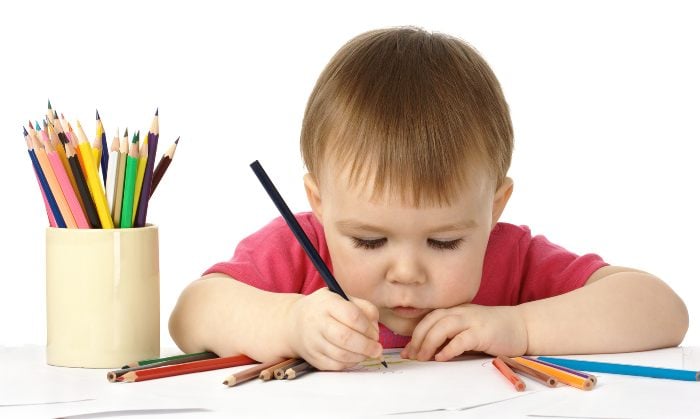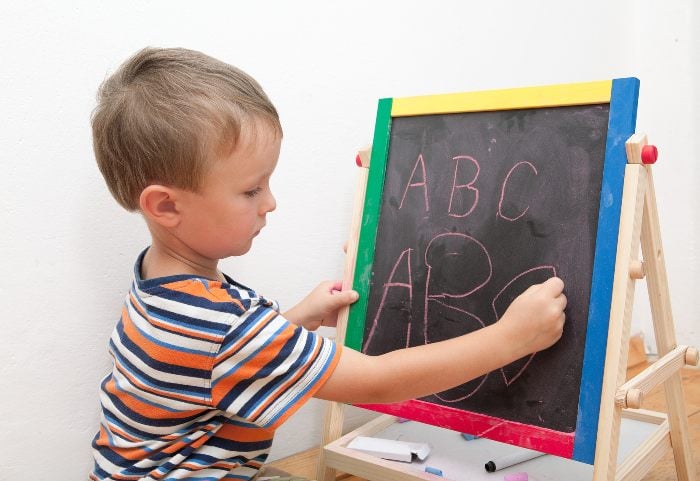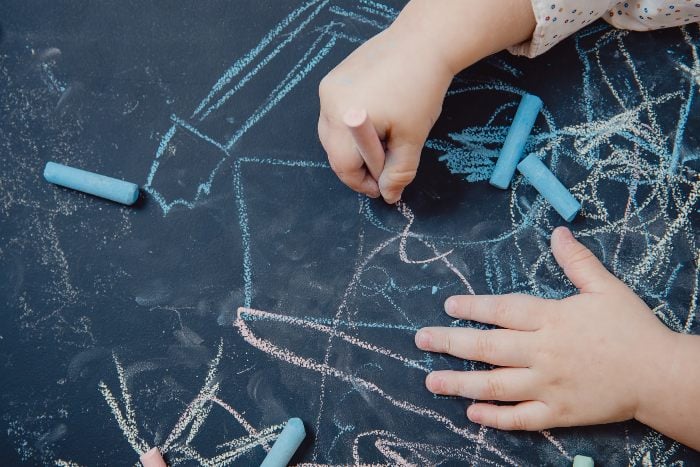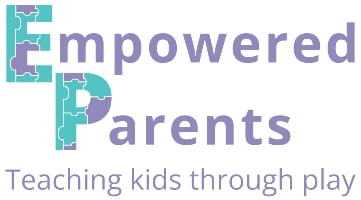Learning to write is a process that starts long before a child can hold a pencil and write letters.
Preschoolers need to learn important foundational skills, called pre-writing skills.
The Process of Learning to Write
There are several reasons why teaching kids to write too early will actually do more harm than good.
It is important to leave the formal writing for when they are developmentally ready.
Children learn through play and are stimulated at their own developmental level while playing. This allows them to naturally progress and mature, developing more advanced skills as they go.
A child is not usually physically and developmentally ready to write during the toddler or preschool years. They will start experimenting with letters on their own and “writing” on their artwork, but they should not be forced to learn the correct letter formation or write on a line.
Here are some reasons why.
Fine Motor Control

During the first few years, children are developing their fine motor control. Their finger muscles need to be strengthened through activities such as drawing, painting, and playing with playdough.
Pencil Grip
When the finger muscles become strengthened, children learn how to hold a pencil correctly, with a tripod grip. This is not easy for young children and they take time to develop this grip by holding crayons, chalk, pencils, etc.
Younger kids will find it easier to hold thicker utensils like jumbo chalk or crayons. As they develop their grip and finger control, they can hold thinner crayons and pencils.

Gross Motor Control
Gross motor control means children are able to move and control their bodies. In order to sit and write at a desk, they must have strong core muscles, good posture and not tire easily.
Large to Small
As children grow, the natural way of developing is usually large to small.
Here are some examples of how you can see this in your children’s development:
- Catching large balls before small ones
- Using thick paintbrushes before fine ones
- Developing large muscles before small muscles
- Reading books with big letters before fine writing
- Building puzzles with large pieces before tiny pieces
This same principle must be applied to teaching children to write. Letters should be introduced in large before small. It is completely inappropriate to expect a young child to form a small intricate letter properly.
You can teach your child to write their name by introducing the letters through play and in a large format before writing them on paper.
Spatial Perception
Children develop spatial perception and a sense of their position in space when playing by doing things like climbing through tunnels and chasing each other.
This helps them, much later, to space letters and words correctly on a page – next to each other, on the line, straight, small enough, starting next to the margin, etc.
Learning to Form Patterns
When formal writing is introduced at school, the teacher does not dive in and show the children how each letter is formed. They start with patterning.
They make zigzags and waves and all sorts of patterns on thick lines before teaching the letters.
These patterns all have shapes that teach the movements that children will use in the letters. A capital letter “A”, for example, has a zig-zag in it and a “C” can be introduced with a curly wave pattern.
When they have learned to make these patterns, letters are introduced, one at a time, with separate lessons for each letter.
The teacher will explain the formation for each one e.g. Start at the top right, go up and around, all the way back up, then down the same line. Children must use the proper formation each time they write a letter.
It does not make sense to skip all these educational practices and teach your young child to write the letters out of the blue.
Having said that, never get in the way of natural learning. If a child is writing letters on their own or forming words, encourage that without trying to correct them.
How to Teach a Child to Write

The good news is, there are lots of things you can do to teach your children the necessary pre-writing skills they need. This will ensure that when they are ready, they will learn to write naturally and with ease.
- Expose children to print often and talk about the print (road signs, books, etc.)
- Model the correct letter formation when writing and put their names on the top of their drawings.
- Develop their fine motor skills.
- Encourage your children to draw, paint and use lots of art materials.
- Develop their gross motor skills.
- Correct their pencil grip or use a rubber pencil grip
.
- Let your children have lots of time for free play.
- Play with wooden, plastic or foam letters.

Loretu
Thursday 9th of May 2024
Wow 😲 got loads of value packed in here. Thanks a lot
Tanja McIlroy
Friday 10th of May 2024
Thanks for your comment, Loretu!
Olusola Aladejebi
Monday 25th of October 2021
Your piece is just so lovely and instructive!
Thanks.
Tanja Mcilroy
Monday 25th of October 2021
Thank you! I'm glad you enjoyed it. Tanja
allison
Sunday 16th of May 2021
Can you share your sources to this post?
Tanja Mcilroy
Monday 17th of May 2021
Hi Allison, apologies - this was one of my first posts on my website and I have since made it my practice to quote all sources. I have added them to the end of the post. Thanks for reading!
Linds
Tuesday 19th of January 2021
If letters have already been introduced at age 4, and writing has been freely practiced (but not drilled or perfected) by tracing letters incorrectly - how can that be remedied early while they are still young before formal school begins?
Tanja Mcilroy
Thursday 21st of January 2021
Hi Linds. Thanks for your comment. At this young age, I would not worry. Simply shift focus to playing with letters freely (like fridge magnets or letters in the bath), or learning just the letters of their name with these kinds of sensory activities https://empoweredparents.co/name-writing-practice/ If they initiate any kind of writing or tracing on their own, that is a normal part of "drawing" and they can be left to it. By the time they are ready for formal writing, they will probably not remember previous formal instruction and be more receptive to learning the correct formation (they will be more likely to remember messy play letters that engage all the senses). Hope that helps a bit! Tanja
Gisele
Sunday 18th of October 2020
What about kids at the age of 3 that love letters and numbers and start writing them without any adult pressure? Should we interfere?
Tanja Mcilroy
Sunday 18th of October 2020
Hi Gisele, good question! No, if they are experimenting with writing numbers and letters on their own then that is wonderful and they should be left to experience it in their own way. The interest is coming from the child so it becomes meaningful and a real learning experience. The child may even start asking about the letters or telling you what they "wrote". Then go with it! It's only the act of sitting a child down to "practise" writing letters before they have the maturity to make sense of them that is not age-appropriate and not a natural way to learn. Experimenting with shapes and letters is part of the stages of drawing development, which slowly morphs into writing. Thanks, Tanja!